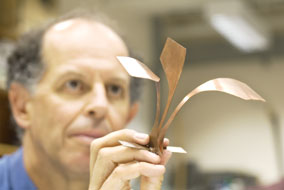
Electrical engineering prof. Matt Yedlin - photo by Martin Dee UBC Reports | Vol. 51 | No. 9 | Sep. 7, 2005
Engineer Discovers Vastly Improved Antenna Design
By Brian Lin
UBC electrical engineers have developed a three-dimensional, ultra-wideband antenna that could significantly improve wireless data transmission for anything from commercial to military communications.
The uniquely shaped antenna -- resembling the fleur-de-lis (FDL) -- not only covers a much wider range of bandwidth than conventional antennas, it produces stable, uniform signals unsurpassed by any existing models.
Invented by recent UBC PhD graduate Kim Dotto, who built the prototype in his garage using copper sheets, the FDL antenna’s flared, horn-like structure has undergone rigorous testing at UBC, the France Telecom Research and Development Laboratory, and the Laboratoire D’Electronique, Antenne et Télécomunications at the Université de Nice.
“We’ve been able to confirm the FDL antenna’s capacity to handle frequency transmissions from two to 26 gigahertz (GHz),” says Matt Yedlin, an associate professor in the Dept. of Electrical and Computer Engineering and Dotto’s PhD advisor.
“To put that in perspective, cellular phones work at around 1.8GHz. Space communications -- such as MOST (Microvariability and Oscillation of STars), Canada’s first space telescope -- come in at 2GHz,” says Yedlin. “Other satellite transmissions range from four to 12GHz.”
“In measurement applications, the FDL antenna covers a bandwidth range that would normally require 30 calibrated antennas,” says Yedlin, who is taking the FDL south of the border for field tests with Seattle Wireless this fall.
The groundbreaking design, which had a U.S. patent issued this June, emerges at a time when the communications industry is desperately seeking ways to expand radio frequencies in order to keep up with tremendous growth in the demand for wireless technology.
The FDL antenna’s ultra-wide bandwidth not only provides a more cost-effective alternative to current infrastructure -- it costs as little as a dollar each to manufacture -- the uniformity of its frequency response opens the door to many new applications.
“The most obvious use is ultra-secure communications for military operations,” says Yedlin. “The FDL antenna enables transmission to be spread over a much wider range of frequencies, making electronic jamming virtually impossible.”
Other applications being investigated include landmine detection, medical imaging -- with the potential to augment X-rays and CT scans -- and non-destructive environmental surveying, such as locating pipes and cable embedded in concrete.
“We’re also considering using the FDL antenna as an inexpensive alternative to radio frequency imaging, a technique that might have huge implications for forestry,” says Yedlin. The new radio frequency imaging technique employs a new mathematical algorithm, developed by PhD candidate Kim Lam, to process the reflected and transmitted waves from a target, such as a tree, to image its interiors. This imaging requires the utilization of the ultra-wideband of frequencies and uniform response provided by the FDL antenna.
“In a selective logging application, foresters could use the FDL antenna to image trees in the potential harvest area. The information from the images can contribute to better planning and ensuring that only the highest-quality lumber is harvested, reducing waste and maximizing foliage and regeneration.” |
